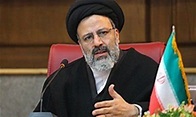WILL NEXT PRESIDENT OF IRAN BE AN EXECUTIONER?

IRAN’S SHAM PRESIDENTIAL ELECTIONS
The presidential elections scheduled for 18th June in Iran will, as usual, be a sham. This time they may be a bigger sham than ever. After 8 years of Hassan Rouhani, 80 million Iranians are sick of him, sick of Supreme Leader Ali Khamenei and sick of the theocratic dictatorship that has wrecked their lives, ruined the economy, forced the majority of the population into abject poverty and turned Iran into an international pariah.
The likelihood is that turnout at the election will be very low. Mojahedin-e Khalq (MEK) resistance units inside Iran report that protesters who are taking to the streets on a daily basis in nationwide demos are shouting slogans to confirm that they will boycott the vote. Turnout could be below 20%. But even if it is, the regime will announce fake figures, in a bid to conceal their embarrassment. We know from bitter past experience that the clerical regime’s elections always involve intimidation, vote-buying, outright ballot-box stuffing and unbridled fakery. Iranians recognize that the presidential elections are nothing more than reshuffles amongst the ruling elite and that Khamenei wields absolute power in the country.
The Guardian Council, which has the final say in who the candidates shall be, is comprised of 6 clerics, who are ardently loyal to the Supreme Leader and are handpicked by him, and 6 jurists, who are appointed by the Head of Judiciary, who is himself appointed by Khamenei. So, the Guardian Council is simply a mouthpiece for the Supreme Leader. His candidates will be the only ones accepted and he will nominate a favourite who will be sure to win the election. Ballot boxes and votes are irrelevant, there only to provide a thin semblance of democracy to the gullible outside world.
The rules are clear. Accepted candidates must be male. No women are allowed to stand for election. They must be Shi’ia Moslem and faithful believers in the system of Velayat-e Faqih, or the absolute rule of the clerics. This thin veneer of righteousness has been used from the early days of the revolution to maintain the pretence of legitimacy. But the Iranian people recognise that Tehran’s clerical leadership has had to rely heavily on coercion, repression, and lethal force in managing its domestic and international affairs. Its external aggression and internal brutality underline its determination to stave off threats to the regime.
The mullahs try to fool the West into believing that there is an on-going struggle between ‘moderate’ reformists, like Rouhani and aggressive hardliners, like former President Ahmadinejad. Western media have fallen for this subterfuge again and again. But the Iranian people know the truth. In daily street protests they can be heard chanting “Reformists and hardliners the game is over,” because they know that all of the mullahs are the same. They are all venally corrupt criminals who are clinging to power by their fingernails, relying on the brutality of the IRGC, the regime’s Gestapo, to crush dissent.
The truth is there are no reformists. It is the hardliners who rule and it will be a hardliner, handpicked by Khamenei, who becomes the next president. Indeed, the leading candidate who is known to be favoured by the Supreme Leader, is Ebrahim Raisi, whom Khamenei regards as “young and pious.” At 60 years of age, he is considered “young’ amongst the geriatric, bearded tyrants who rule Iran. He will almost certainly be manoeuvred into the role of President following the sham elections, on the direct command of the Supreme Leader.
Raisi was born in 1960. He started training as a cleric in the main seminary in the Holy City of Qom at 15 years of age and entered the clerical regime’s judiciary from early on, as assistant prosecutor in Karaj (West of Tehran) when he was 19 years old. He never studied law, but his loyalty and enthusiasm for the Islamic fundamentalists was his ticket to promotion. He became the prosecutor of the revolutionary court of Karaj when he was just 20.
In 1988, as Deputy Prosecutor of Tehran, he was one of the four individuals whom the then Supreme Leader Khomeini appointed to carry out his infamous fatwa to massacre imprisoned activists of the opposition MEK. During that massacre, 30,000 political prisoners, primarily affiliated with the MEK, were summarily executed within a few months. For his work as a ruthless executioner, Raisi was promoted to the position of Tehran Prosecutor in 1989. He held that position for five years. In 2012 he became Deputy Head of the Judiciary and then Judiciary Chief in March 2019. Since then, he has directed the execution of 251 people in 2019, and 267 people in 2020, and scores of executions in 2021. Raisi was placed on the US Treasury black list on 10th November 2019, for human rights violations.
If Raisi becomes president it will be the straw that breaks the camel’s back. If he wins the sham election, Western politicians can no longer look at a revived nuclear deal as a potential springboard to détente, rapprochement and a more normal bilateral relationship. Iran has, through its hostile acts, repeatedly dashed such hopes and forfeited its role as a conventional nation. Tehran’s clerical leadership has relied so heavily on intimidation, subjugation, and lethal force in managing its domestic and international affairs, that Western appeasers who have sought to restore normal relations with the mullahs have lost all credibility. The presidential elections on 18th June will be the last, desperate throw of the dice for a bankrupt, toxic and dangerous regime, hated by their own population and distrusted by the international community. With their downfall imminent, Iran’s next president may be the clerical regime’s last.
